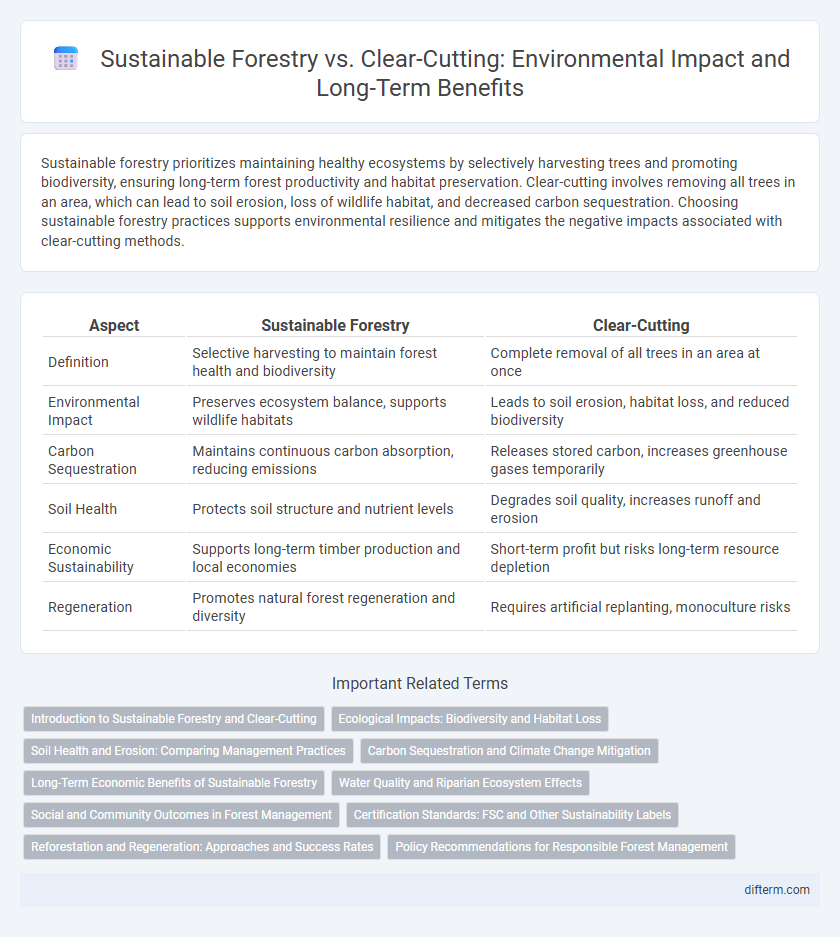Sustainable forestry prioritizes maintaining healthy ecosystems by selectively harvesting trees and promoting biodiversity, ensuring long-term forest productivity and habitat preservation. Clear-cutting involves removing all trees in an area, which can lead to soil erosion, loss of wildlife habitat, and decreased carbon sequestration. Choosing sustainable forestry practices supports environmental resilience and mitigates the negative impacts associated with clear-cutting methods.
Table of Comparison
| Aspect | Sustainable Forestry | Clear-Cutting |
|---|---|---|
| Definition | Selective harvesting to maintain forest health and biodiversity | Complete removal of all trees in an area at once |
| Environmental Impact | Preserves ecosystem balance, supports wildlife habitats | Leads to soil erosion, habitat loss, and reduced biodiversity |
| Carbon Sequestration | Maintains continuous carbon absorption, reducing emissions | Releases stored carbon, increases greenhouse gases temporarily |
| Soil Health | Protects soil structure and nutrient levels | Degrades soil quality, increases runoff and erosion |
| Economic Sustainability | Supports long-term timber production and local economies | Short-term profit but risks long-term resource depletion |
| Regeneration | Promotes natural forest regeneration and diversity | Requires artificial replanting, monoculture risks |
Introduction to Sustainable Forestry and Clear-Cutting
Sustainable forestry emphasizes the responsible management of forest resources to maintain ecosystem health, biodiversity, and long-term productivity, promoting selective harvesting and natural regeneration. Clear-cutting involves the removal of all or most trees in an area, leading to significant habitat disruption, soil erosion, and loss of carbon storage capacity. Understanding these contrasting practices is essential for balancing economic needs with environmental conservation and climate change mitigation.
Ecological Impacts: Biodiversity and Habitat Loss
Sustainable forestry practices promote biodiversity by maintaining diverse habitats and protecting soil and water resources, which supports ecosystem resilience and wildlife populations. Clear-cutting leads to significant habitat loss, soil erosion, and disruption of ecological networks, causing declines in species richness and ecosystem services. Preservation of native vegetation through selective logging can mitigate negative impacts on flora and fauna, contrasting sharply with the extensive environmental degradation caused by clear-cutting.
Soil Health and Erosion: Comparing Management Practices
Sustainable forestry practices maintain soil health by preserving organic matter and minimizing disturbance, which reduces erosion and supports biodiversity. In contrast, clear-cutting exposes soil to heavy erosion due to the removal of vegetation, leading to nutrient depletion and increased runoff. Effective management prioritizes soil stability and long-term productivity through selective harvesting and maintaining ground cover.
Carbon Sequestration and Climate Change Mitigation
Sustainable forestry maintains diverse forest structures that enhance carbon sequestration by preserving soil integrity and promoting long-term biomass growth, significantly aiding climate change mitigation efforts. Clear-cutting disrupts this balance by releasing stored carbon into the atmosphere and reducing the forest's ability to absorb CO2, thereby exacerbating greenhouse gas accumulation. Implementing sustainable practices ensures continuous carbon capture, supports biodiversity, and stabilizes local and global climate systems.
Long-Term Economic Benefits of Sustainable Forestry
Sustainable forestry practices ensure continuous timber production by maintaining healthy forest ecosystems, promoting biodiversity, and preventing soil erosion, which supports long-term economic viability. Unlike clear-cutting, sustainable methods reduce costs associated with land degradation and harvesting inefficiencies, resulting in stable income streams for local communities and industries. Investment in sustainable forestry leads to increased forest resilience and carbon sequestration, enhancing ecosystem services that contribute to economic growth over time.
Water Quality and Riparian Ecosystem Effects
Sustainable forestry practices enhance water quality by preserving soil structure and minimizing sediment runoff, which protects aquatic habitats in riparian ecosystems. Clear-cutting increases erosion and nutrient loading, leading to degraded water quality and disrupted habitat for fish and other wildlife. Maintaining buffer zones in riparian areas during timber harvesting is critical for sustaining biodiversity and preventing water pollution.
Social and Community Outcomes in Forest Management
Sustainable forestry promotes long-term social and community benefits by preserving local biodiversity and supporting the livelihoods of indigenous and rural populations through steady resource availability. Clear-cutting often leads to social disruption, including loss of traditional forest-based jobs and increased vulnerability of communities to environmental hazards such as soil erosion and water contamination. Community involvement in sustainable forestry practices enhances social cohesion and empowers stakeholders in decision-making processes, fostering resilience and equity in forest-dependent regions.
Certification Standards: FSC and Other Sustainability Labels
Sustainable forestry prioritizes long-term ecosystem health by adhering to certification standards like the Forest Stewardship Council (FSC), which ensures responsible forest management, biodiversity conservation, and social benefits. Clear-cutting often lacks such certifications, leading to significant environmental degradation and loss of habitat diversity. Other sustainability labels, such as PEFC (Programme for the Endorsement of Forest Certification), also promote best practices but vary in rigor and geographic focus compared to FSC standards.
Reforestation and Regeneration: Approaches and Success Rates
Sustainable forestry emphasizes selective logging and natural regeneration, promoting diverse ecosystems and higher long-term reforestation success rates compared to clear-cutting, which often relies on artificial planting and faces slower ecosystem recovery. Reforestation approaches in sustainable forestry include mixed-species planting and maintaining seed trees, enhancing soil stability and biodiversity. Clear-cutting's uniform regrowth can increase vulnerability to pests and erosion, reducing overall forest resilience and ecological function.
Policy Recommendations for Responsible Forest Management
Implementing sustainable forestry policies that enforce selective logging, reforestation, and biodiversity protection reduces ecological disruption compared to clear-cutting practices. Governments should establish regulatory frameworks mandating certification systems like FSC (Forest Stewardship Council) to ensure responsible harvesting and maintain ecosystem services. Financial incentives and community involvement further enhance compliance and promote long-term forest health and carbon sequestration.
Sustainable forestry vs Clear-cutting Infographic

 difterm.com
difterm.com